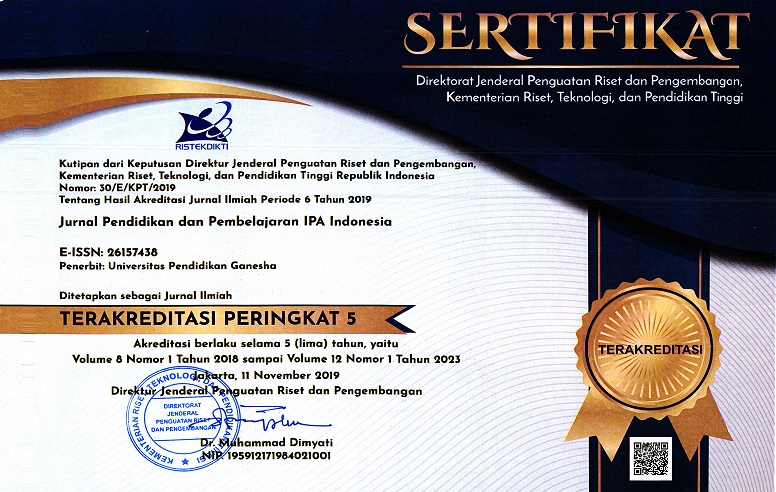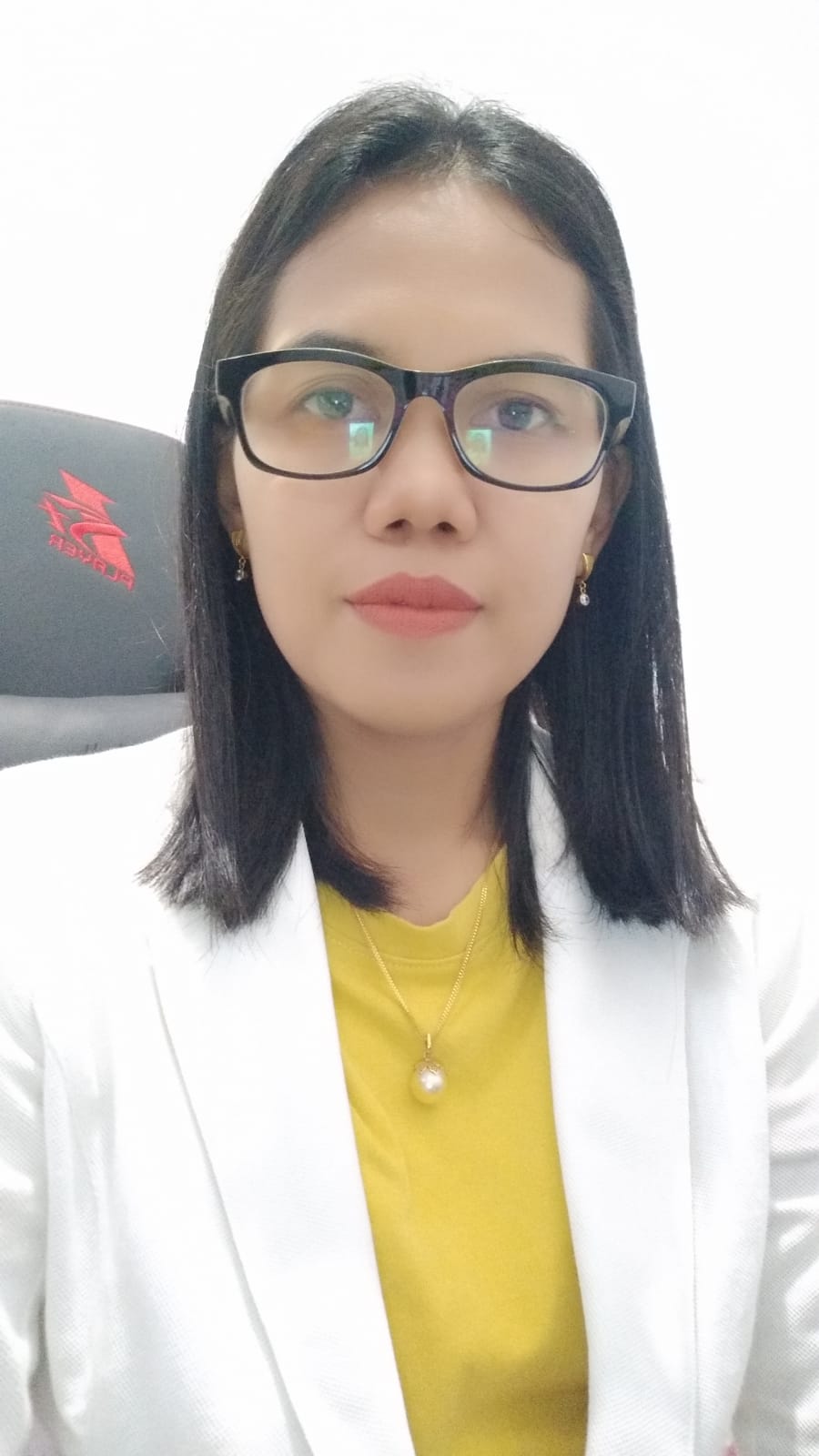ANALISIS KEMAMPUAN LITERASI SAINS DALAM PEMBELAJARAN IPA DI SEKOLAH DASAR
DOI:
https://doi.org/10.23887/jppii.v14i2.83933Keywords:
Kemampuan Literasi Sains; Pembelajaran IPA SDAbstract
This study aims to determine the ability of students' science literacy in science learning in grade V elementary school. The research was conducted at SDN 17 Ampenan with 26 students as respondents. The type of research used is qualitative research. The instrument used was a science literacy test with 12 items and interviews. Data analysis was carried out by categorizing students' science literacy skills consisting of three categories, namely high, medium and low categories. The results showed that in the aspect of students' science literacy competence with high category was 19.35%, science literacy competence with medium category was 45.16% and science literacy competence with low category was 35.48%. This shows that the number of students in the category of science literacy skills at SDN 17 Ampenan is mostly in the medium category, followed by students with low competence and few students who have high science competence.
References
Annisa, N. (2023). Prospective elementary school teachers perceptions on the use of technology in natural science learning. Joease, 1(1), 27-35. https://doi.org/10.62672/joease.v1i1.7
Avikasari, A., Rukayah, R., & Indriayu, M. (2018). The influence of science literacy-based teaching material towards science achievement. International Journal of Evaluation and Research in Education (Ijere), 7(3), 182. https://doi.org/10.11591/ijere.v7i3.14033
Bungin. (2015). Analisis Data Penelitian Kualtatif. Rajawali Pers.
Faisal, S. (2023). Science literacy assessment instrument for additives and addictive substances: development, validation, and rasch model analysis. Jurnal Penelitian Pendidikan IPA, 9(10), 7826-7836. https://doi.org/10.29303/jppipa.v9i10.4376
Fatonah, S. (2023). Implementation of the kurikulum merdeka in natural and social science learning to strengthen elementary students' independence. Al-Bidayah Jurnal Pendidikan Dasar Islam, 15(2), 243-266. https://doi.org/10.14421/albidayah.v15i2.845
Fitri, A. Z., & Haryanti, N. (2020). Metodologi Penelitian Pendidikan: Kuantitatif, Kualitatif, Mixed Method, dan Research and Development.Madani Media.
Harefa, E. (2023). Implementation of scientific inquiry approach for enhancing scientific literacy among elementary students. iraono, 1(1), 32-38. https://doi.org/10.56207/iraono.v1i1.131
Hernawati, D. and Maulina, D. (2023). Students’ cognitive ability: its relationship with ability in scientific literacy and student self-efficacy., 436-444. https://doi.org/10.2991/978-2-38476-060-2_40
Kartimi, K. & Winarso, W. (2021). Enhancing students’ science literacy skills; implications for scientific approach in elementary school. Al Ibtida Jurnal Pendidikan Guru Mi, 8(2), 161. https://doi.org/10.24235/al.ibtida.snj.v8i2.9175
Lestari, H. & Rahmawati, I. (2020). Integrated stem through project based learning and guided inquiry on scientific literacy abilities in terms of self-efficacy levels. Al Ibtida Jurnal Pendidikan Guru Mi, 7(1), 19. https://doi.org/10.24235/al.ibtida.snj.v7i1.5883
Lestari, H., Setiawan, W., & Siskandar, R. (2020). Science literacy ability of elementary students through nature of science-based learning with the utilization of the ministry of education and culture's "learning house". Jurnal Penelitian Pendidikan IPA, 6(2), 215-220. https://doi.org/10.29303/jppipa.v6i2.410
Odden, T., Marin, A., & Rudolph, J. (2021). How has science education changed over the last 100 years? an analysis using natural language processing. Science Education, 105(4), 653-680. https://doi.org/10.1002/sce.21623
OECD. (2016). PISA 2015 Assessment and Analytical Framework. Paris: OECD Publishing. OECD, (2018). PISA 2015 Results in Focus. https://www.oecd.org/pisa/pisa-2015-results-in-focus.pdf.
OECD. (2019). PISA 2018 Insight and Interpretations. https://www.oecd.org/pisa/
Pratiwi, S.N., C Cari , dan N. S. Aminah. (2019). Pembelajaran IPA Abad 21 dengan Literasi Sains Siswa. Jurnal Materi dan Pembelajaran Fisika (JMPF), 9(1), 34-42. . https://doi.org/10.20961/jmpf.v9i1.31612
Putri, R. M., Setiadi, D., Mahrus, M., & Jamaluddin, J. (2022). Analisis Pembelajaran Daring dan Kemampuan Literasi Sains Biologi serta Berpikir Kritis Siswa di SMA Negeri 1 Woha pada Masa Pandemi Covid-19. Jurnal Ilmiah Profesi Pendidikan, 7(2c), 747-754. https://doi.org/10.29303/jipp.v7i2c.619
Redhana, I. W. (2019). Mengembangkan Keterampilan Abad Ke-21 dalam Pembelajaran Kimia. Jurnal Inovasi Pendidikan Kimia, 13(1), 2019, 2239-2253. https://doi.org/10.15294/jipk.v13i1.17824.
Rosfiani, O., Hermawan, C., & Sutisnawati, A. (2022). Developing 21st century skills and literacy skills for elementary school students through constructivist-based planning and assessment of critical engagement models., 414-421. https://doi.org/10.2991/978-2-494069-91-6_65
Rusilowati, A. (2018). Asesmen Literasi Sains: Analisis Karakteristik Instrumen dan Kemampuan Siswa Menggunakan Teori Tes Modern Rasch Model. Prosiding Seminar Nasional Fisika Universitas Riau Ke-3. https://snf.fmipa.unri.ac.id/wp-content/uploads/2019/03/0.-300B-2-15NI.pdf
Sugiyono. (2014). Metode Penelitian Kuantitatif, Kualitatif dan R&D. Bandung: Alfabeta.
Suryawan, A. (2023). The validity of the pro-based caturalis learning model to improve elementary school students’ scientific literacy., 74-80. https://doi.org/10.2991/978-2-38476-118-0_9.
Susiloningsih, E. (2023). Experiential learning model in science learning: systematic literature review. Jurnal Penelitian Pendidikan IPA, 9(9), 550-557. https://doi.org/10.29303/jppipa.v9i9.4452
Tetep, T. (2023). The use of learning media-based augmented reality (ar) to improving integrated science and social studies literacy. Jurnal Pendidikan Progresif, 13(3), 1267-1275. https://doi.org/10.23960/jpp.v13.i3.202328
Wright, K. (2023). Trade books to the rescue!: combating misinformation with science and literacy. The Reading Teacher, 77(4), 485-494. https://doi.org/10.1002/trtr.2264
Xu, T. (2023). Structural relationship on factors influencing digital literacy of college students. International Journal of Emerging Technologies in Learning (Ijet), 18(19), 147-159. https://doi.org/10.3991/ijet.v18i19.38319






